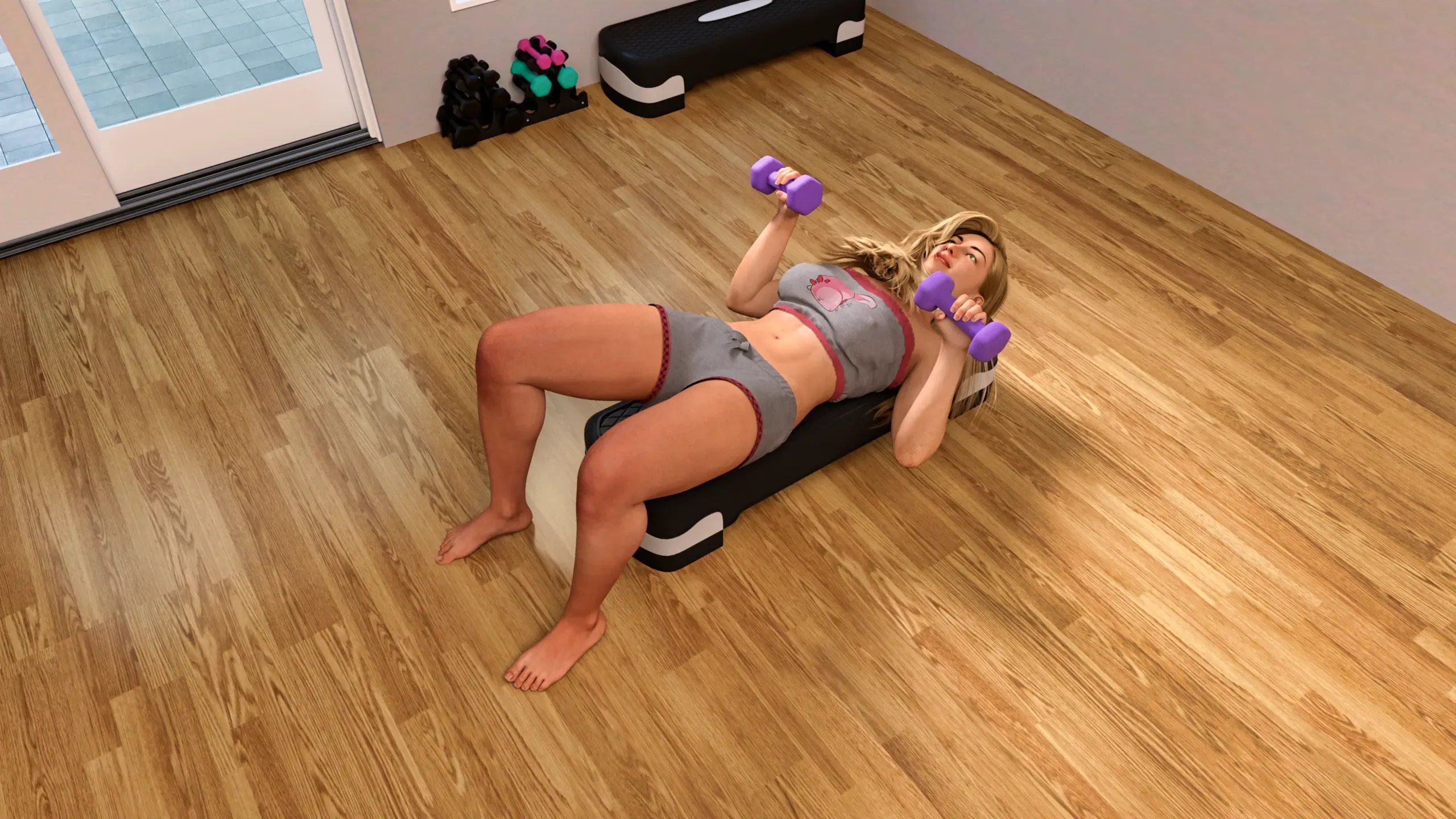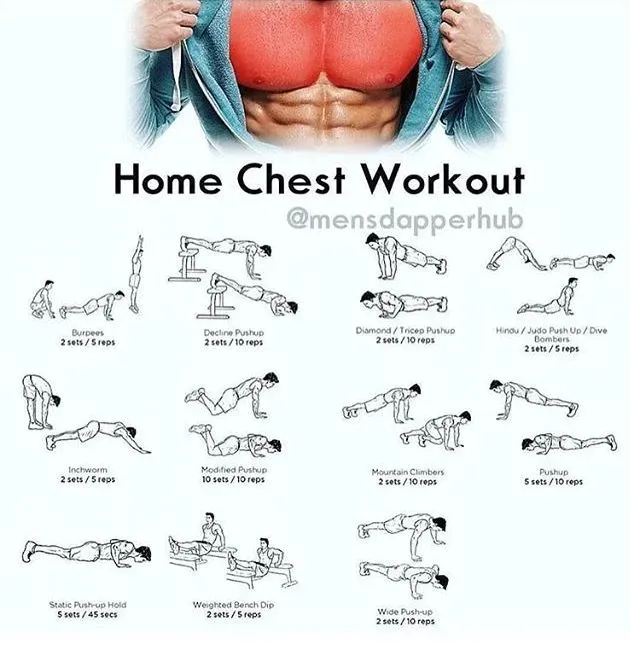Table of Contents
Alright, let's talk chest day. You want that solid, strong chest, but maybe hitting the gym isn't your thing right now, or frankly, it's just a hassle. So, you think about working out at home. The big question pops up: can you really build a decent chest without a bunch of fancy machines? And more specifically, what kind of equipment for chest workout at home actually makes a difference, or do you even need any?
Do You Really Need Equipment for Chest Workout at Home?

Do You Really Need Equipment for Chest Workout at Home?
Let's get straight to it: Do you really need equipment for chest workout at home? For many people, the answer is a resounding no, at least not to start seeing results. Your own body weight is a remarkably effective tool. Think about push-ups in their countless variations – they hit your chest, shoulders, and triceps hard. You can build significant strength and muscle definition just by mastering different push-up angles and intensities. Calisthenics, or bodyweight training, offers a fantastic foundation and can challenge even advanced athletes. Before you drop cash on gear, explore what you can do with zero equipment. It might surprise you how much you can achieve.
Essential Equipment for Chest Workout at Home: The Basics

Essential Equipment for Chest Workout at Home: The Basics
Resistance Bands: Your Portable Powerhouse
so maybe you've crushed every push-up variation known to humankind and you're thinking, "Alright, what's next without buying a whole gym?" If you're looking for minimal investment and maximum versatility when considering equipment for chest workout at home, resistance bands are your best friend. These aren't those flimsy therapy bands; get some decent quality loops or tube bands with handles. They provide tension throughout the movement, which is different from free weights, and they're incredibly light and portable. You can use them for band-assisted push-ups if you're not quite there yet, or for band-resisted push-ups to add challenge. They're also fantastic for fly movements, mimicking cable crossovers you'd do at the gym.
Adjustable Dumbbells: The Classic Choice
If you have a bit more space and budget, adjustable dumbbells are probably the single best piece of equipment for chest workout at home you can get. Why adjustable? Because they save a ton of space compared to a full rack of weights, and you can change the weight as you get stronger. Dumbbell presses and flyes are fundamental chest exercises that target the muscle fibers differently than push-ups. You can do them lying on the floor or, if you have one, a bench. They allow for a greater range of motion than fixed bars and help identify and correct strength imbalances between your left and right sides. It's a solid investment for progressive overload.
- Resistance Bands (various tensions)
- Adjustable Dumbbells (start with a manageable range)
- A Sturdy Chair or Bench (for elevated push-ups or presses)
- Maybe a Mat (for comfort on the floor)
Using What You Have: Chairs and Floors
You don't even need fancy equipment for chest workout at home to add variety and intensity if you have basic household items. A sturdy chair or coffee table works perfectly for incline or decline push-ups, shifting the focus to different parts of your chest. Incline push-ups (hands on the elevated surface) target the lower chest, while decline push-ups (feet on the elevated surface) hit the upper chest more. The floor itself is your primary training ground for standard push-ups. Get creative with angles and hand positions. Sometimes the simplest tools are the most effective when you know how to use them right.
Level Up Your Equipment for Chest Workout at Home: Beyond Dumbbells

Level Up Your Equipment for Chest Workout at Home: Beyond Dumbbells
Gymnastic Rings and Parallettes: Unstable Gains
so you've got the basics down. Push-ups are feeling solid, and maybe you've added some dumbbell work. What's next if you want to really push your home chest training? Think instability. This is where equipment like gymnastic rings or parallettes comes into play. Rings, hung from a sturdy beam or pull-up bar, force your stabilizer muscles into overdrive. A simple push-up on rings becomes a whole new beast, demanding control and hitting those chest fibers from angles static movements can't. Parallettes, those mini parallel bars, allow for a deeper range of motion on exercises like dips and push-ups, increasing the stretch on the chest muscles at the bottom of the movement. Adding these to your equipment for chest workout at home setup introduces a challenge that builds not just strength, but also incredible body control and joint stability.
Dip Stations and Weight Vests: Adding Resistance
If rings feel a bit too advanced or require ceiling fixtures you don't have, a standalone dip station is another excellent piece of equipment for chest workout at home. These allow you to perform dips, a compound exercise that hammers the lower chest, shoulders, and triceps. Finding one that's stable and fits your space is key. Another way to increase resistance without adding bulky plates is a weight vest. Slap on a vest, and suddenly your standard push-ups, dips, or even plyometric push-ups become significantly harder, allowing you to progressively overload your bodyweight exercises. These tools bridge the gap between pure bodyweight and heavy free weights, offering versatile ways to make your existing movements more challenging and continue building that chest.
- Gymnastic Rings (require a sturdy anchor point)
- Parallettes (great for deeper push-ups and L-sits)
- Dip Station (targets lower chest and triceps)
- Weight Vest (adds resistance to any bodyweight move)
Building a Full Chest Routine with Your Home Equipment

Building a Full Chest Routine with Your Home Equipment
Starting Point: Exercise Selection
you've got some equipment for chest workout at home now, whether it's just your floor or you've invested in some bands or dumbbells. The first step in building a routine isn't just doing random exercises until you feel the burn. It's about selecting movements that actually hit the chest muscles effectively. Think about the basics: pressing motions and flying motions. Push-ups cover pressing with just bodyweight. Add dumbbells, and you open up flat presses, incline presses (using a chair), and decline presses. Resistance bands let you do band-resisted push-ups or band flyes, mimicking cable machines. A solid routine needs a mix, targeting different angles of the chest.
Structuring Your Workout: Sets, Reps, and Progression
So, you've picked your exercises. Now, how many times do you do them? For building muscle and strength, aim for 3-4 sets per exercise. The number of repetitions per set depends on your goal and the exercise difficulty. If you can do 20+ perfect push-ups easily, you need a harder variation or added resistance from bands or a vest. If you're using dumbbells, aim for reps where the last couple are challenging but you can maintain good form, typically 8-15 reps for muscle growth. The key is progressive overload – making it harder over time. This could mean more reps, more sets, a harder exercise variation, slower negatives, or adding resistance with your equipment for chest workout at home.
- Standard Push-Ups (Bodyweight)
- Incline Push-Ups (Chair/Table)
- Decline Push-Ups (Chair/Table)
- Dumbbell Floor Press (Dumbbells)
- Dumbbell Flyes (Dumbbells)
- Resistance Band Push-Ups (Bands)
- Resistance Band Flyes (Bands)
- Dips (Dip Station or sturdy parallel surfaces)
Consistency and Recovery: The Unsung Heroes
You can have the best equipment for chest workout at home and the perfect exercise list, but if you aren't consistent, it's all just decoration. Aim to hit your chest muscles 2-3 times per week, allowing at least 48 hours of rest between sessions for recovery and growth. Listen to your body; if something feels sharp or wrong, back off. A quick warm-up before you start – maybe some arm circles, light push-ups on your knees, or seal jacks – gets the blood flowing. Stretching afterward can also help. Remember, the workout is just the stimulus; the magic happens when you're resting and recovering.
Making the Most of Your Equipment for Chest Workout at Home

Making the Most of Your Equipment for Chest Workout at Home
Mastering Form Over Maxing Out Weight
Look, having equipment for chest workout at home, whether it's just the floor or a shiny new set of adjustable dumbbells, doesn't automatically grant you superhero strength. The absolute most crucial thing is form. Doing 50 sloppy push-ups where your back is sagging or your elbows are flaring out does way less for your chest than 10 perfect ones with a full range of motion. Same goes for dumbbells. Slamming weights up and down with no control is an express ticket to injury, not gains. Focus on the muscle working, control the negative (lowering the weight), and squeeze at the top. Quality trumps quantity every single time when you're using your equipment for chest workout at home.
Get Creative with What You Have
You don't need a dedicated cable machine to get a good chest fly. Resistance bands anchored around a sturdy pole or door handle work just fine. No incline bench? Stack some books or use the armrest of a couch for elevated push-ups or presses. That awkward space between two sturdy chairs? Perfect for dips. The beauty of equipment for chest workout at home, especially minimal gear, is that it forces you to be resourceful. Think about the movement pattern you want to hit – pressing, flying, dipping – and then look at your space and gear. How can you replicate that movement safely and effectively? Often, the solution is simpler than you think.
- Elevate feet for decline push-ups (targets upper chest).
- Elevate hands for incline push-ups (targets lower chest).
- Use bands for resistance in push-ups or flyes.
- Perform dumbbell presses on the floor if no bench is available.
- Try single-arm variations with dumbbells for unilateral strength.
Consistency and Tracking Progress
The best equipment for chest workout at home is useless if it just collects dust. Showing up consistently is half the battle, maybe more. Aim for 2-3 chest sessions a week. And don't just go through the motions; track what you're doing. Write down the exercises, sets, reps, and any resistance used (band color, dumbbell weight). This isn't just busywork; it's how you ensure you're actually progressing. If you did 3 sets of 10 push-ups last week, aim for 3 sets of 11 or maybe try a slightly harder variation this week. Are you getting stronger with your equipment for chest workout at home? The numbers don't lie. If you're plateauing, look at your logs and figure out where you need to add more challenge or perhaps adjust your form or rest.
Wrapping Up Your Home Chest Gains
So, there you have it. Building a strong chest at home doesn't require turning your living room into a commercial gym. While bodyweight exercises form a solid foundation, adding some key equipment for chest workout at home can definitely expand your options and help you push past plateaus. Start simple – resistance bands, adjustable dumbbells, maybe a sturdy bench down the line. Consistency and proper form beat having every piece of gear imaginable. Figure out what fits your space, budget, and goals, and put in the work. Your chest will thank you.
